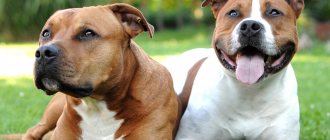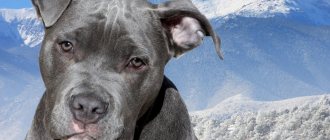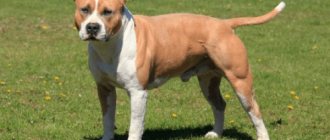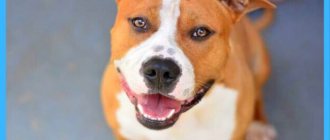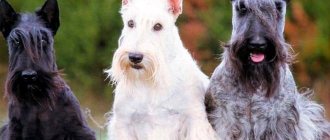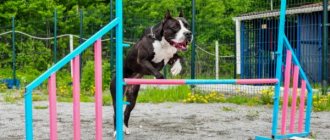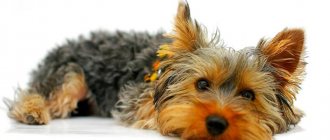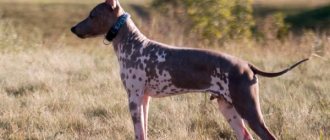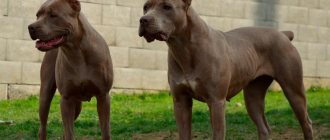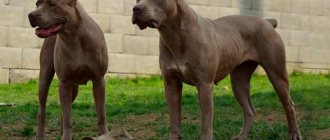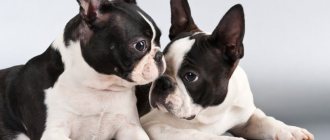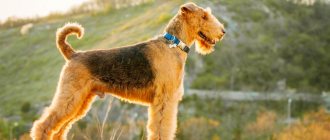The American Staffordshire Terrier, also called Staff, Amstaff or Stafford, is considered a truly versatile dog. Among the Staffords you can often find detectives, rescuers and guides. But they gained their popularity more as family dogs - loyal, brave, smart and loving children. In addition, Staffordshire Terriers love to spend time actively and will gladly accompany their owner on fishing, travel and sports.
Brief history of origin
The United States of America is considered the birthplace of the breed. The ancestors of Staffords in Medieval England were regular participants in dog competitions with bears, bulls and wild boars. In 1835, the English Parliament banned all fighting involving bulls, but, unfortunately, fights between dogs were invented almost immediately.
Because of such an unpleasant past, American Staff Terriers have long been considered exclusively fighting dogs - dangerous, aggressive and unpredictable.
Since 1930, Amstaffs have not officially taken part in battles. Now the opinion about them has changed in the opposite direction - representatives of the breed are only show dogs for exhibitions and companions.
Staffordshire Terrier: interesting facts
The history of the breed goes back almost two centuries, but despite this, every year these Staffords do not lose their popularity throughout the world. Several interesting facts will give you the opportunity to get to know American Staffordshire Terriers better:
- Staffs serve in special detachments that are part of the Russian Ministry of Emergency Situations. Dogs of this particular breed were able to locate terrorists with explosives after the terrorist attack in the building of the Theater Center on Dubrovka.
- Staffords love to lie on the couch with their owners and watch TV.
- In Ukraine there is a youth clothing brand called Staff in honor of the American Staffordshire Terriers.
- Staffordshire Terrier puppies are constantly looking for something to chew, so the owner needs to purchase several chew toys for them.
- Representatives of the breed are excellent rat catchers. This ability, apparently, they inherited from their ancestors - English terriers.
Accustoming to neatness
In general, the Stafford should be trained by rewarding desirable behavior.
You need to take the puppy outside to do his “business” every time he eats or wakes up, and also every two to three hours.
Yes, it’s troublesome, but literally in a week or two the baby will understand what they want from him, and there will be no problems with puddles and piles.
Stafford puppies are particularly savvy, as are shorthaired pointer cubs .
As soon as the dog appears in your home, determine where his place to rest and sleep will be. It’s good when the baby chooses a corner for himself where you take his bed
It is also important to be attentive: if the terrier begins to worry and look for somewhere to relieve himself, quickly take him outside.
Important! After each successful trip to the toilet, you should praise the puppy vigorously. He should feel that the “deed” he has done makes his owner very happy.
As soon as the dog appears in your home, determine where his place to rest and sleep will be.
It’s good when the baby chooses a corner for himself where you take his bed. Perhaps the dog will like the place that you offer him.
If the dog doesn’t like it, you will have to look for a compromise, otherwise the baby will try in every possible way to escape from the unloved place.
The Stafford family is ready to go
Staffordshire Terrier breed standards
In 1936, the American Kennel Club approved the first breed standard. On May 26, 1971, the American Staffordshire Terrier was officially registered
International Canine Federation. The FCI standard gives the following description of the breed:
- The weight of males should be 25–30 kg, females – 22–25 kg.
- The height of “boys” is 46–48 cm, “girls” is 43–46 cm.
- The head is medium-sized, wide, with a clearly visible transition from the forehead to the muzzle.
- The jaws are strong. Scissor bite. The teeth are large and white.
- The ears are set high and wide, can be cropped or undocked, but erect or raised.
- The nose is black, large, with wide open nostrils.
- The eyes are dark, small, deep-set.
- The neck is of medium length, has no folds or dewlap, and looks massive.
- The chest is wide, with slightly protruding ribs.
- The back is straight, short, muscular.
- The limbs are straight, strong, with developed muscles, located parallel to each other. The front ones are widely spaced.
- The paws are small and rounded.
- The tail is short, straight, set low, tapering towards the end.
- The coat is short, straight, fairly thick, shiny, close to the body, and hard.
- The color is varied: single-color, two-color, brindle or spotted.
Important. Completely drooping ears are unacceptable for American Terriers and are considered a defect.
Height and weight chart
An inexperienced dog breeder needs to carefully monitor the development of his little pet, so data on the approximate weight and height in the first year and a half of his life will not be superfluous.
| Age, months | Weight, kg | Height, kg |
| 1 | 2,5–4 | Not taken into account |
| 2 | 6–9 | 25–30 |
| 3 | 9–14 | 30–36 |
| 4 | 14–20 | 35–44 |
| 5 | 17–24 | 38–46 |
| 6 | 19–28 | 42–50 |
| 9 | 24–33 | 42–50 |
| 12 | 25–35 | 43–50 |
| 18 | 25–38 | 44–50 |
This is interesting! The weight of newborn American Staffordshire Terrier puppies, depending on gender, is 250–400 g.
Breed traits
Breed traits (on a 5-point scale)
| American Staffordshire Terrier | |||
| Activity | in the house | 3.3 | |
| on the street | 4.7 | ||
| Obedience | training | 3.3 | |
| strangers | 3.3 | ||
| Domination | in family | 2.3 | |
| over dogs | 4.3 | ||
| Defending your territory | from people | 3 | |
| from dogs | 4.3 | ||
| Sociability | in family | 5 | |
| with strangers | 2.7 | ||
| with dogs | 2.7 | ||
| Concentration | in family | 1 | |
| in front of strangers | 2.7 | ||
| with dogs | 2.7 | ||
| Aggressiveness | in family | 1 | |
| to strangers | 2 | ||
| to the dogs | 2.3 | ||
| to cats | 3 | ||
| Family behavior | calmness | 4.3 | |
| demand for affection | 5 | ||
| excitability | 4 | ||
| playfulness | 4.7 | ||
| excessive barking | 1 | ||
| behavioral breakdowns | 3 | ||
| Tolerance for children | up to 4 years | 4.3 | |
| over 4 years old | 4.3 | ||
| Institutional use | watchman | 4 | |
| bodyguard | 3.3 | ||
This breed is often compared to the following dog breeds: Cane Corso, German Shepherd, Rottweiler, Doberman (Doberman Pinscher), Staffordshire Bull Terrier.
Photos of American Staffordshire Terriers:
American Staffordshire Terrier
American Staffordshire Terrier
Staffordshire Terrier - varieties
Staffordshire Terriers are divided into several types:
- English Staffordshire Terrier (other names: English Staffordshire Bull Terrier, Staff Bull, Staffie);
- American pit bull terrier (another name is pit bull);
- American Staffordshire Terrier;
- standard bull terrier;
- dwarf bull terrier.
These breeds have common ancestors - bulldogs. All these dogs were bred to participate in battles of various specializations. The smallest of these breeds are the dwarf bull terriers, which are a mini version of the standard bull terrier. American Staffordshire Terriers and American Pit Bull Terriers are very similar at first glance, but Amstaffs have a more proportional build. Pit bulls are not recognized by the FCI, so they do not participate in official competitions and exhibitions.
American Terriers, among other things, come in several types:
- proportional – the appearance of staffs of this type is closest to the current standard;
- bulldog-shaped - in appearance, these Staffordshire terriers are more reminiscent of bulldogs: they are inactive, weigh more than 45 kg, have a short neck and a rough build;
- terrier - these Amstaffs have more qualities of terriers: very active, weigh up to 30 kg, have a long neck and a narrow, slightly elongated mouth.
This is interesting. Staffordshire Terriers of proportional type are extremely rare.
How to choose a puppy?
Be sure to pay attention to the registration of the nursery, documents of the parents (including pedigrees). There must certainly be a pedigree for the puppy. If a puppy is rejected based on its exterior, it will be stamped “Not for breeding use,” but a pedigree will still be issued. This is not a guarantee of quality, but a birth certificate and proof that you are taking a purebred dog and not a crossbreed.
Look to see if the baby's coat is shiny, if the belly is swollen, if the paws are bent, and find out what the puppy is fed.
A puppy can be adopted at the age of 2 months. By this time, the babies have already stopped suckling from their mother and are ready to move to a new family; moreover, they actively “demand” their person, because they need a lot of attention.
Breeder's Observation: It doesn't matter who you get, male or female. Males are generally more honest and simple, females are more cunning. But rather, this is a matter of personal preference. I personally don't see any difference.
Color and appearance
According to the current standard, the colors of Stafford dogs are usually as follows:
- Black Amstaffs have a bright and deep color without shades. There may also be small spots on the paws and chest.
- Blue Amstaffs. The coat color of Blue Staffordshire Terriers ranges from light blue to dark blue shades. The nose of dogs is blue (matching the color of their coat). Dark blue Staffords have almost black noses.
- Red Staffords have a uniform coat color, and in individuals with the so-called “boar” color, the main background is red and dark on top.
- The American Black Boston Terrier's coat is a combination of white and black: it is white on the face, neck, paws and back, and the rest of the body is black.
- Among brindle-colored Staffords there are individuals of reddish or brindle colors. Their fur comes in different shades - from red to red.
- In Staffies with a blue-fawn color, the coat has a silvery coating. These dogs' noses are always gray and their eyes are dark.
On a note. The main requirement of the FCI is that white spots should occupy no more than 80% of the dog’s body. In addition, liver, black and tan, and solid white coats are considered faulty.
Staffordshire Terrier - character and behavior
Despite what most people think, Staffordshire Terriers are kind, cheerful, and balanced dogs by nature. They do not show unmotivated aggression towards strangers. Also, representatives of the breed will never bark over trifles.
Staffs can be aggressive towards smaller animals, and even get into fights with their relatives. This behavior is usually the result of improper upbringing.
Staffordshire Terriers are infinitely devoted to their owner and his family members and love to be the center of attention. In addition, Amstaffs are very attentive: having excellent facial expressions, they literally catch the owner’s facial expression on the fly and try to repeat it.
This is interesting. Among Staff Terriers there are individuals who are terrified of fireworks. The owners of such dogs have to insert earplugs into their pets' ears during fireworks.
Attitude towards children
Staffordshire Terriers have an amazing ability to distinguish children from adults. These dogs are deservedly recognized as one of the best nannies: they adore children - when playing with them, they become more gentle and careful, and in case of danger they will immediately rush to their defense. However, it is better not to leave young children alone with staff.
Watchdog and security qualities
Any experienced dog breeder knows that the Staffordshire Terrier has pronounced watchdog and security qualities. In case of any threat, representatives of the breed will protect the owner, members of his family and the entrusted territory. An angry Staffordshire Terrier dog is difficult to stop - they usually fight until they are completely victorious. Thanks to their endurance and enormous strength, staffs can cope with several opponents at once, and their well-developed intuition helps to predict the next actions of their opponents.
Owner reviews
Often, owners note the fact that this breed is so trusting of people that it is easy to steal.
- “When a completely stranger appears in a dog’s life, she examines him with interest and can easily leave with him. After all, this is a person!
- “This is a dog that endlessly loves the whole world, every person, not to mention children. She is ready to always be near a person and play with him, so that the person constantly strokes her. It’s hard not to notice!”
- “This is the first dog that didn’t try to bite me.” This was said by a dog trainer who boasts many years of experience working with different breeds of dogs.
TOP names and nicknames for the Staffordshire Terrier
Usually, kennels give dogs names that are too long or unpronounceable. For everyday life, the owner can come up with a more suitable nickname - the main thing is that it is sonorous, short and easy to pronounce.
For males
The most suitable nicknames for a Staffordshire Terrier boy could be:
- Art;
- The battle;
- Lord;
- Butch;
- Rich;
- Caesar;
- Max;
- Gore;
- Bard;
- Jack;
- Ram;
- North.
For girls
The following nicknames are perfect for a Staffordshire Terrier girl:
- Alma;
- Reed;
- Gina;
- Irma;
- Varna;
- Willow;
- Mara;
- Rose;
- Yuma;
- Donna;
- Storm;
- Lada.
Staffordshire Terrier - care and maintenance
Representatives of the American Staffordshire Terrier breed are considered quite unpretentious. They can live both in a city apartment and in a country house. However, with the latter option, the dog cannot be kept on the street - put on a chain or in an enclosure.
Amstaffs should only live indoors where they have a spacious, warm place without dampness or drafts.
Ear cropping of Staff puppies is an important point in dog ownership. Not so long ago, this procedure was considered mandatory, since docking was provided for by the breed standard. Now in many countries cupping is allowed only for medical reasons.
If the owner nevertheless decides to give the pet an appearance according to the standard, then it is better to carry out this procedure at the age of 1.5 to 3 months.
During this period, dogs are not as sensitive to pain, are less likely to develop complications, and are also more likely to get the correct shape of their ears. Ear cropping surgery is performed under general anesthesia. Afterwards it is recommended to wear a protective collar.
The veterinarian removes the sutures from the ears a week after the procedure, but to avoid bleeding, the head will remain bandaged for some time.
Important. The dog's ears will be sore for 2-3 days after surgery. If your dog has a hard time with this period, you can use painkillers.
Staffordshire Terrier - proper diet
For a balanced diet for their pet, the owner can choose both ready-made food and natural food. However, when feeding natural food, it is necessary to add vitamins and minerals. American Terriers are a breed prone to overeating, so the owner needs to be especially careful when planning their diet and diet.
On a note. Both an adult Staffordshire Terrier and a puppy need to be fed at the same time, after a walk.
The basis of the diet (about 75%) of an adult Staffordshire Terrier should be raw, lean meat, which must be cut into small pieces before serving.
Meat can be diluted with the following products:
- porridge from rice, corn, buckwheat and millet cereals;
- well-cooked offal;
- vegetables;
- greenery;
- fruits;
- dairy products;
- sea fish without bones.
More detailed information about the dog’s diet is presented in the article “What to feed the Staffordshire Terrier.”
It is strictly forbidden to give representatives of the breed:
- legumes;
- sweets;
- spices;
- fat meat;
- smoked meats;
- boiled potatoes;
- porridge from pearl barley and oatmeal.
For full development and muscle growth, American Staffordshire Terrier puppies need to be fed very well. About 30% of your puppy's diet should be lean meat. Next, you need to gradually introduce all foods from the diet of an adult dog. In addition, diet is very important for puppies.
Usually newborn babies feed on mother's milk. In the absence of it, puppies two months and younger should eat 6 times a day, from 2–4 months – 5 times, from 5 to 11 months – 4 times, and per year, Staffy puppies should eat no more than 3 times a day. The dog is switched to two meals a day after 18 months.
Important. Frequently feeding adult Staffies bones can cause constipation and damage to tooth enamel. American Staffordshire Terrier puppies under 7 months old should not be given bones.
Walking and exercise
Staffordshire Terriers, like all active dogs, love long walks, during which they can run, play and carry out tasks for their owner. In the warm season, you can include swimming in open waters in your walk. If the dog does not have the opportunity to release its pent-up energy on a walk, it will begin to damage things in the house.
Important. When walking in crowded areas, the dog should always be on a leash and muzzle.
Training and education
Education and training should be a mandatory part of keeping a Staffordshire Terrier. Staffies are very smart dogs. They quickly understand what is wanted from them, but due to their natural stubbornness they may refuse to carry out some commands. In order to properly raise a Staff puppy, you need to build a hierarchy almost from the first days of the baby’s stay in the house, becoming an unconditional authority for him.
All family members must adhere to the same parenting style, without allowing concessions. Also, dogs of this breed need early socialization, which in the future will eliminate aggression towards people and other animals.
For more details, see “Education and training of staff.”
Stafford training should be regular (at least 2-3 hours a day) and consistent. If the owner does not have the skills and knowledge necessary for training, it is imperative to contact an experienced dog handler.
The best methods for raising a Staffordshire Terrier are attention, play and treats. These dogs are very sensitive, so physical punishment is prohibited, otherwise the staff may become angry with the owner or become cowardly.
Staffordshire Terrier - hygiene
Hygienic care for representatives of the breed is minimal and boils down to washing, caring for hair and eyes, cleaning ears and teeth, and trimming nails. Amstaff should be taught these mandatory procedures from a very early age.
Caring for the coat of Staffordshire Terriers is very simple: you need to brush the dog weekly with a special massage brush. It is not recommended to bathe Staffies completely more than once a month - this can harm their skin and coat.
After each walk, it is enough to wash your paws with a special shampoo. In addition, we must not forget about regular treatment of wool from external parasites.
Discharge in the corners of the eyes should be removed daily with a piece of bandage soaked in boiled warm water. Ears should also be checked regularly for dirt and cleaned weekly with a cotton pad soaked in a special solution.
Teeth brushing should be done weekly using special toothbrushes and toothpastes. Staffordshire Terriers' nails usually wear down on their own, but if this does not happen, they need to be trimmed carefully.
Care
Amstaffs are smooth-haired dogs, and therefore sensitive to cold. Some of my dogs are quite reluctant to go for walks even in rainy weather. I am not a fan of dressing dogs; I prefer active walking in winter, because the paws are the first to get cold, and no fur coat can save them. If it’s very cold (below -20 degrees), we walk very actively, and when I see that our paws are freezing, we go home. In this case, it is better to go for a walk more often.
Amstaffs do not tolerate heat very well, but they do not suffocate like dogs with a short muzzle. Naturally, I do not recommend going on a bike ride with your amstaff in extreme heat.
Sometimes caring for smooth-haired dogs is more difficult than long-haired ones, so don’t be fooled by the apparent ease of caring for this breed. Amstaffs shed, and the wool, like needles, gets stuck in the carpets. Shedding occurs 2 times a year: in spring and autumn. But now there are special brushes, furminators, that make life easier for owners.
As for bathing, I wash my dogs only before shows. But they are “clean spitters,” so there is no need for frequent water treatments.
Amstaffs have a wool smell, but it is not as pronounced as in many other breeds.
Vaccinations and susceptibility to disease
American Staffordshire Terriers must receive annual preventive vaccinations against rabies and other deadly infections. In addition, deworming should always be carried out before vaccination.
Amstaffs are considered a fairly healthy breed, but they also have a tendency to some “breed” diseases:
- hip dysplasia;
- allergy;
- various eye diseases;
- bloating;
- benign tumors.
The achievements of modern veterinary medicine make it possible to timely diagnose and cure many diseases, or at least make the dog’s life easier. Owners just need to carefully monitor any deviations in the pet’s condition.
Exercise stress
Stafford puppies need to go for walks a lot. However, you should not drive your dog until he is exhausted, this will only harm him.
An attentive owner will determine when the dog is tired and it is time to return home.
On average, you need to walk your puppy for 40 minutes or more twice a day. At the same time, it is necessary to organize games for him with elements of education; agility .
From 4-5 months you can start visiting the training ground.
If a child spoils household things, looks for “adventures”, is mischievous and does not want to respond to commands, most likely he does not go out enough.
Unused energy spills out in the form of unwanted behavior.
After all, not only adults, but also Stafford puppies have quite a lot of strength; it is not so easy to take a photo in which the baby is sitting calmly.
If your baby spoils household things, is looking for “adventures,” is mischievous, and does not want to respond to commands, most likely he is not getting enough exercise.
